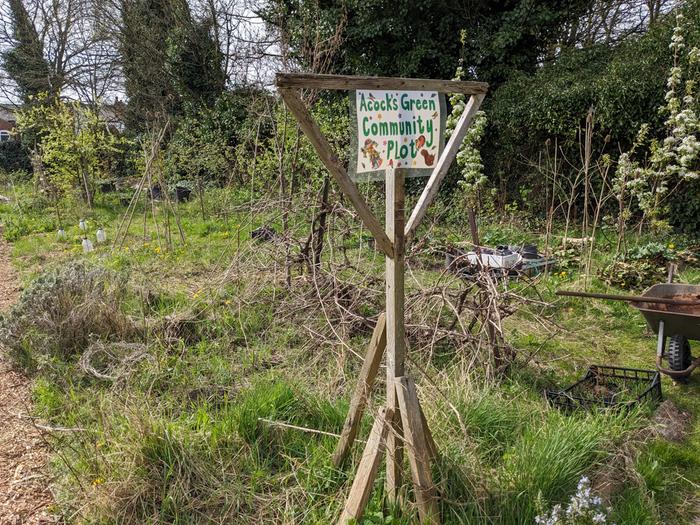
 9
9




--
"Whitewashed Hope: A Message from 10+ Indigenous Leaders and Organizations"
https://www.culturalsurvival.org/news/whitewashed-hope-message-10-indigenous-leaders-and-organizations

 2
2




How Permies works: https://permies.com/wiki/34193/permies-works-links-threads
My projects on Skye: The tree field, Growing and landracing, perennial polycultures, "Don't dream it - be it! "
 4
4




Nancy Reading wrote:Sounds exciting AC! Quite a bit of grass in the centre and some pallets? You could maybe propagate more fruit into the unplanted area when you do remedial pruning over winter.
--
"Whitewashed Hope: A Message from 10+ Indigenous Leaders and Organizations"
https://www.culturalsurvival.org/news/whitewashed-hope-message-10-indigenous-leaders-and-organizations
 2
2




Invasive plants are Earth's way of insisting we notice her medicines. Stephen Herrod Buhner
Everyone learns what works by learning what doesn't work. Stephen Herrod Buhner
 4
4




--
"Whitewashed Hope: A Message from 10+ Indigenous Leaders and Organizations"
https://www.culturalsurvival.org/news/whitewashed-hope-message-10-indigenous-leaders-and-organizations
 6
6




Ac Baker wrote:
As for specifics, I think the shade on the West of the plot is a bit too profound: the fruit trees are growing asymetrically toward the East. I am minded to slightly lift the canopy, as the tall trees are mostly ash & sycamore so forgiving & lacking edible fruit. In late winter, as the inedible-to-us fruit is ending, I will also take back the encroaching English ivy towards the fence. This will improve access & air circulation too.
All the fruit is going to need attention: strawberry runners to clear around & transplant; raspberry canes, presumed tayberry, currants to carefully prune I'm case they are wrongly identified! Purple gooseberries need some restoration pruning. Grapevine needs a substantial re-shape! All of these I intend to try to propagate too, for myself and for the community.
We have already done a restoration prune on the presumed damson, as this apparently reduces their susceptibility to fungal infection compared to autumn pruning.
Then the apples & pears need a light prune too.
Besides all this, we need to cut some paths into the long grass, mulch around the fruit, and edit out the unwanted volunteers including dozens of second year sycamore seedlings ...
We also have herbs around the grapevine: a lot of green sage, a rosemary hanging in there, and I think a fair bit of marjoram. I will have to ask our community food project if they are interested in fresh herbs (they almost always have used dried so far, donations of fresh being rare).
So, lots to do, and of course, lots more to observe from closer proximity. Oh, and I caught up with another gardening neighbour today who is keen to visit, so will hopefully help out in due course!
 3
3




Alan Burnett wrote:
It sounds like a lot to do, but I think you have the right idea!
Sycamore and Ash, I agree they have to go, too much shade to keep around. Sycamore is a serious shade tree, so unless it's right on the north edge of the plot I think it ought to come down. Ash might be useful for coppice if it comes down too, those might make good grapevine poles or fencing, though it's a bit slow to rely on that coppice for the restoration you're working on.
Alan Burnett wrote:
Since you have a set of volunteers, I would suggest making some month-by-month tasks. Depending on your zone, maybe November is a good time to transplant the dormant raspberries and grapes, which means you want to prepare the transplant destination ahead of time. So I might write
September - clear tree saplings in raspberry area
Alan Burnett wrote:
October - cut back grasses in raspberry area and paths
November - cut back and transplant raspberry crowns
Alan Burnett wrote:
With all the pieces in motion, you will probably have several tasks lined up for each month, which you can share with your volunteers and make short term plans for.
I would love to see more of the plot, especially once the unwanted growth is cut back and only the more welcomed food producers remain. I would also enjoy seeing a map of the plot and where the sun hits.
--
"Whitewashed Hope: A Message from 10+ Indigenous Leaders and Organizations"
https://www.culturalsurvival.org/news/whitewashed-hope-message-10-indigenous-leaders-and-organizations
 2
2




--
"Whitewashed Hope: A Message from 10+ Indigenous Leaders and Organizations"
https://www.culturalsurvival.org/news/whitewashed-hope-message-10-indigenous-leaders-and-organizations












 1
1




How Permies works: https://permies.com/wiki/34193/permies-works-links-threads
My projects on Skye: The tree field, Growing and landracing, perennial polycultures, "Don't dream it - be it! "
 2
2




Nancy Reading wrote:Ooh pears! That's lovely too! Harvesting fruit might be nice for volunteers to help with.
Nancy Reading wrote:Hard pruning of grapes is usually best done when dormant in winter - if you leave it too long the plants can bleed badly (I think you can collect the sap like birch and maple sap...). In summer you can prune back the new growth though to keep it under control (they can put on a lot of growth).
Nancy Reading wrote:I remember Martin Crawford saying that ash were the most problem weeds in his forest garden....I have killed a sycamore sapling by repeated rubbing out of new growth during the growing season - that might be an option if you have ones in useful places for structures perhaps. It saves digging the roots out.

--
"Whitewashed Hope: A Message from 10+ Indigenous Leaders and Organizations"
https://www.culturalsurvival.org/news/whitewashed-hope-message-10-indigenous-leaders-and-organizations
 4
4




--
"Whitewashed Hope: A Message from 10+ Indigenous Leaders and Organizations"
https://www.culturalsurvival.org/news/whitewashed-hope-message-10-indigenous-leaders-and-organizations
 5
5




--
"Whitewashed Hope: A Message from 10+ Indigenous Leaders and Organizations"
https://www.culturalsurvival.org/news/whitewashed-hope-message-10-indigenous-leaders-and-organizations

















How Permies works: https://permies.com/wiki/34193/permies-works-links-threads
My projects on Skye: The tree field, Growing and landracing, perennial polycultures, "Don't dream it - be it! "
 2
2




Nancy Reading wrote:Hi Ac,
Cute robin! They are always please to see a gardener
Nancy Reading wrote:There is still a lot of overhang on that ivy. Pity the trees are planted so close to that boundary; the soft fruit would have been far more tolerant of a shady location. Hopefully what you have done will help them a bit though.
Nancy Reading wrote:If you get any bullace suckers I wouldn't mind one please. It's one form of plum that doesn't seem to be as widely available, but being a native plant (I think) is more likely to grow well for me.
--
"Whitewashed Hope: A Message from 10+ Indigenous Leaders and Organizations"
https://www.culturalsurvival.org/news/whitewashed-hope-message-10-indigenous-leaders-and-organizations
 4
4





--
"Whitewashed Hope: A Message from 10+ Indigenous Leaders and Organizations"
https://www.culturalsurvival.org/news/whitewashed-hope-message-10-indigenous-leaders-and-organizations
 3
3




--
"Whitewashed Hope: A Message from 10+ Indigenous Leaders and Organizations"
https://www.culturalsurvival.org/news/whitewashed-hope-message-10-indigenous-leaders-and-organizations
 5
5





--
"Whitewashed Hope: A Message from 10+ Indigenous Leaders and Organizations"
https://www.culturalsurvival.org/news/whitewashed-hope-message-10-indigenous-leaders-and-organizations












 2
2




How Permies works: https://permies.com/wiki/34193/permies-works-links-threads
My projects on Skye: The tree field, Growing and landracing, perennial polycultures, "Don't dream it - be it! "
 4
4




--
"Whitewashed Hope: A Message from 10+ Indigenous Leaders and Organizations"
https://www.culturalsurvival.org/news/whitewashed-hope-message-10-indigenous-leaders-and-organizations
 2
2




I do Celtic, fantasy, folk and shanty singing at Renaissance faires, fantasy festivals, pirate campouts, and other events in OR and WA, USA.
RionaTheSinger on youtube
 3
3




Riona Abhainn wrote:Thanks for keeping us updated about how the community plot is going, how many people are involved in it so far?
--
"Whitewashed Hope: A Message from 10+ Indigenous Leaders and Organizations"
https://www.culturalsurvival.org/news/whitewashed-hope-message-10-indigenous-leaders-and-organizations
 1
1




I do Celtic, fantasy, folk and shanty singing at Renaissance faires, fantasy festivals, pirate campouts, and other events in OR and WA, USA.
RionaTheSinger on youtube
 2
2




--
"Whitewashed Hope: A Message from 10+ Indigenous Leaders and Organizations"
https://www.culturalsurvival.org/news/whitewashed-hope-message-10-indigenous-leaders-and-organizations
















Pear midge causes the fruitlets to blacken and drop off; inspection reveals maggots within
Always remove all mummified fruits and dead wood immediately
How Permies works: https://permies.com/wiki/34193/permies-works-links-threads
My projects on Skye: The tree field, Growing and landracing, perennial polycultures, "Don't dream it - be it! "
 1
1




--
"Whitewashed Hope: A Message from 10+ Indigenous Leaders and Organizations"
https://www.culturalsurvival.org/news/whitewashed-hope-message-10-indigenous-leaders-and-organizations
















How Permies works: https://permies.com/wiki/34193/permies-works-links-threads
My projects on Skye: The tree field, Growing and landracing, perennial polycultures, "Don't dream it - be it! "
 1
1




--
"Whitewashed Hope: A Message from 10+ Indigenous Leaders and Organizations"
https://www.culturalsurvival.org/news/whitewashed-hope-message-10-indigenous-leaders-and-organizations
 3
3




--
"Whitewashed Hope: A Message from 10+ Indigenous Leaders and Organizations"
https://www.culturalsurvival.org/news/whitewashed-hope-message-10-indigenous-leaders-and-organizations

















How Permies works: https://permies.com/wiki/34193/permies-works-links-threads
My projects on Skye: The tree field, Growing and landracing, perennial polycultures, "Don't dream it - be it! "
 3
3




Ac Baker wrote:Unfortunately, almost all our pear fruitlets are . shrunken & blackened.
--
"Whitewashed Hope: A Message from 10+ Indigenous Leaders and Organizations"
https://www.culturalsurvival.org/news/whitewashed-hope-message-10-indigenous-leaders-and-organizations
 3
3




--
"Whitewashed Hope: A Message from 10+ Indigenous Leaders and Organizations"
https://www.culturalsurvival.org/news/whitewashed-hope-message-10-indigenous-leaders-and-organizations
 1
1




I do Celtic, fantasy, folk and shanty singing at Renaissance faires, fantasy festivals, pirate campouts, and other events in OR and WA, USA.
RionaTheSinger on youtube
 1
1




--
"Whitewashed Hope: A Message from 10+ Indigenous Leaders and Organizations"
https://www.culturalsurvival.org/news/whitewashed-hope-message-10-indigenous-leaders-and-organizations
 3
3




--
"Whitewashed Hope: A Message from 10+ Indigenous Leaders and Organizations"
https://www.culturalsurvival.org/news/whitewashed-hope-message-10-indigenous-leaders-and-organizations
 1
1




--
"Whitewashed Hope: A Message from 10+ Indigenous Leaders and Organizations"
https://www.culturalsurvival.org/news/whitewashed-hope-message-10-indigenous-leaders-and-organizations
 1
1




I do Celtic, fantasy, folk and shanty singing at Renaissance faires, fantasy festivals, pirate campouts, and other events in OR and WA, USA.
RionaTheSinger on youtube
















How Permies works: https://permies.com/wiki/34193/permies-works-links-threads
My projects on Skye: The tree field, Growing and landracing, perennial polycultures, "Don't dream it - be it! "
 1
1




Nancy Reading wrote:It may be worth starting a new thread on the bench water harvesting...were you thinking of building some sort of rain shelter over the bench so that (if you get any) you can sit in the dry while it rains, or somehow collecting rain off the bench itself?

--
"Whitewashed Hope: A Message from 10+ Indigenous Leaders and Organizations"
https://www.culturalsurvival.org/news/whitewashed-hope-message-10-indigenous-leaders-and-organizations
 4
4




--
"Whitewashed Hope: A Message from 10+ Indigenous Leaders and Organizations"
https://www.culturalsurvival.org/news/whitewashed-hope-message-10-indigenous-leaders-and-organizations












 2
2






How Permies works: https://permies.com/wiki/34193/permies-works-links-threads
My projects on Skye: The tree field, Growing and landracing, perennial polycultures, "Don't dream it - be it! "

| I agree. Here's the link: http://stoves2.com |






